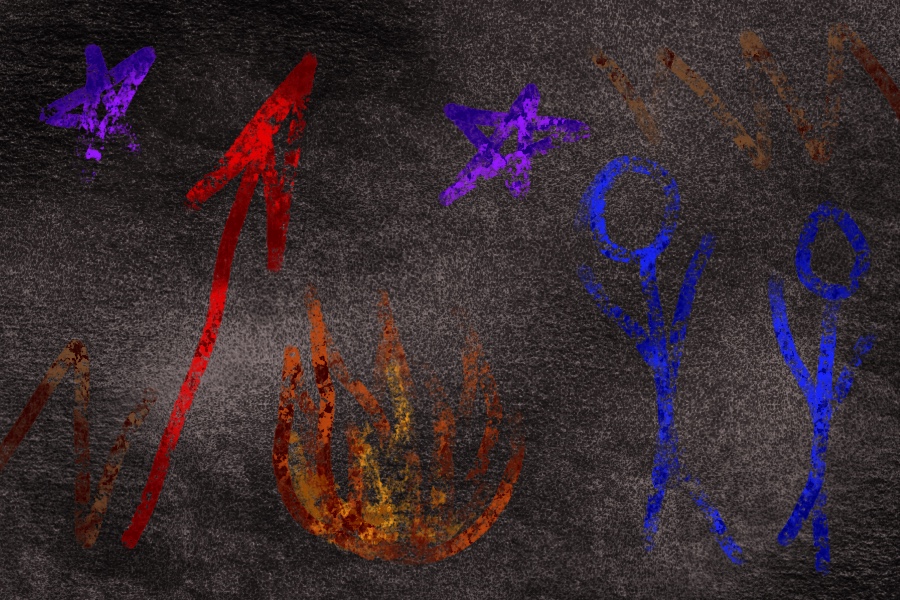
UC Davis study looks at human evolution through drawing ability
Neanderthals, unlike modern humans, have not been credited with artistic abilities, specifically because of the lack of cave art dated to when they existed. Richard Coss, a professor emeritus of psychology at UC Davis, authored a paper that proves his hypothesis that the lack of cave art by Neanderthals is connected to their ability to hunt. Coss conducted two studies to develop the hypothesis that humans experienced evolutionary changes due to an arms race with increasingly wary sub-Saharan African game.
The first study was a comparative study of wild horses and zebras with then-graduate student in psychology Alexali Brubaker, who is now research coordinator for the Third Millennium Alliance.. This study showed that wild horses in Nevada could be approached on foot more closely than zebras living near settlements in East Africa. However, both wild horses and zebras, when not exposed to humans, were much more wary when approached on foot. This finding showed that wild horses could adjust to humans sufficiently well for taming quickly, while zebras routinely exposed to humans retained considerable wariness, precluding their domesticability.
“The theoretical argument for this incomplete habituation is that human ancestors in sub-Saharan Africa hunted game relatively consistently for more than 1 million years,” Coss said. “As African game became progressively warier of ancestral humans, maintaining larger flight distances, ancestral humans compensated initially by throwing spears and later by adopting longer-range bow and arrow.”
The second was a study done with Vivek Thuppil, a doctoral graduate in the Animal Behavior Graduate Group at UC Davis, on ways to mitigate crop raiding in southern India. What they observed was that Asian elephants can be tamed relatively quickly for working, while African elephants were difficult to tame and remained dangerous. This observation led to the theory that African elephants are more naturally aggressive toward humans as a by-product of being hunted persistently for a long period by ancestral humans. This is in contrast to Asian elephants experiencing relatively recent hunting by modern humans after they left Africa.
Coss’ study proposes a causal relationship between an evolved ability of anatomically modern humans to throw spears accurately while hunting and their ability to draw representational images from working memory. Neanderthals did not have to hunt increasingly wary game like archaic and anatomically modern humans did, and therefore could use close-range thrusting spears. Archaic and anatomically modern humans in sub-Saharan Africa adopted longer-range hunting practices using hand-cast spears because they couldn’t get as close to the animals as Neanderthals could. This difference in hunting style led to progressive enlargement of the parietal cortex during human evolution, the part of the brain that integrates visual imagery and motor coordination. Such enlargement is evident in the globular shape of the human cranium, whereas the Neanderthal cranium is flatter.
Soon after this paper was published, another paper, written by Dirk Hoffmann, a post-doctoral researcher at the Max Planck Institute for Evolutionary Anthropology, and his colleagues potentially disproved Coss’ argument.
“Professor Coss wrote a brilliant article in which he tried to explain why the Neanderthals were not known to produce the well-known art seen in the caves of Southwestern Europe,” said Dean Simonton, a distinguished professor emeritus in the Department of Psychology at UC Davis. “This failure [to produce well-known art] is attributed to the different hunting practices of the Neanderthals in comparison to the modern humans who showed up later — and who had already started to produce such art in Africa before their migration. “
Simonton believes that the cave paintings referenced in Coss’ paper were incorrectly dated using the traditional radiocarbon technique; the relatively accurate uranium-thorium dating method puts the painting at about 20,000 years before the arrival of modern humans.
“By default, that means that the Neanderthals must have been very good artists after all, which throws an unanticipated monkey wrench in his argument,” Simonton said. “To be sure, he concentrates on a particular cave in France, whereas the [study by Hoffman] looks at three caves in Spain. But even if modern humans produced the former — the modern [uranium-thorium] dating has yet to be applied — they could not have created the latter.”
However, the paper may not completely invalidate Coss’ research. According to Nicolas Zwyns, an assistant professor in the Department of Anthropology at UC Davis, to invalidate Coss’ model, there would need to be proof that a significant portion of the Paleolithic figurative cave art was made by Neanderthals.
“The paintings [in Hoffman’s study] include a red painted speleothem, a hand stencil and some linear motives [and] would predate the first H. sapiens occupation in the region by thousands of years,” Zwyns said. “With the same method, the team dated a putative red pigment container at Cueva de los Aviones. This object would have been used for body painting activities pre-dating the oldest known example from South-African example. Consider as whole, these testimonies would suggest that Neanderthal would engage in esthetic and perhaps symbolic behaviors. Furthermore, the implications would only confirm a use of pigments or abstract drawings by other members of the genus Homo that is already suspected. It doesn’t demonstrate a non-H. sapiens production of figurative art and therefore, it would not invalidate Dr. Coss’s hypothesis.”
The debate about Neanderthals and cave art has been ongoing.
“Were Neanderthals thinking the way we do?” Zwyns said. “For a long time, a debate opposed scholars who consider Homo sapiens as an exception to those who suggest that Neanderthal and modern human cognitive skills were alike. Among the numerous and unambiguous material testimonies of H. sapiens symbolic thoughts documented for at least 40,000 years, is the spectacular cave art. In comparison to this rich record, the evidence for such behavior among Neanderthals and the other members of the genus Homo is scarce and often debatable.”
Written by: Kriti Varghese — science@theaggie.org



